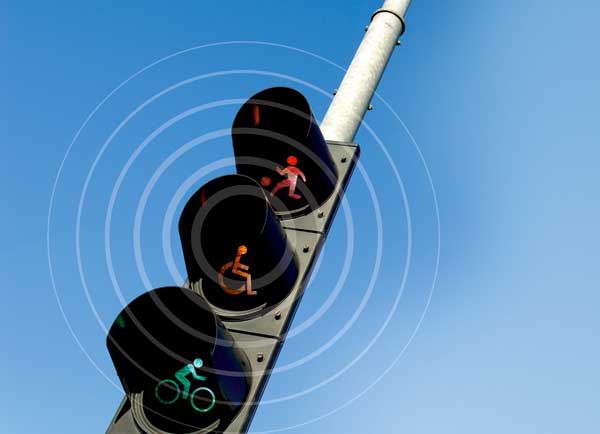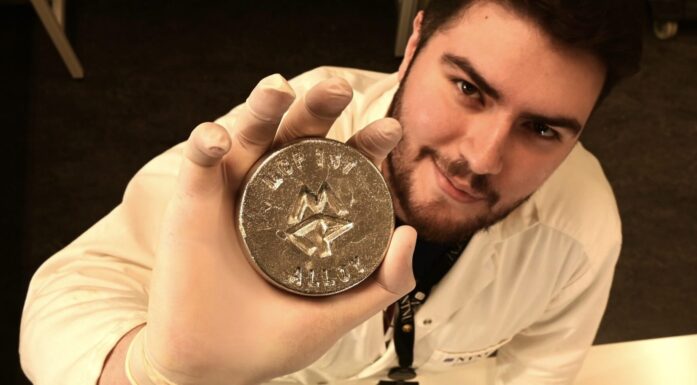Smart traffic lights know if you’ll go
Who are you, and where are you going? A smart traffic light knows.
A traffic light that knows who you are and which way you plan to go when you’re out walking does sound a bit scary. But is it really possible? The answer is – yes.
A smart traffic light sees non-motorists, analyses their movements and decides whether each object it sees – a bicyclist or pedestrian – is close to the traffic light and is likely to cross at the zebra crossing.
“When we know what pedestrians actually plan to do, we can improve the efficiency of traffic signals. For example, there is no reason for a light to change if there are no pedestrians nearby. As a result, traffic can flow more smoothly and will be more environmentally friendly. If there is less stop-and-go driving, we can reduce the amount of CO2 and NOx that cars emit,” explains Anders Kofod-Petersen.
Kofod-Petersen is an expert on artificial intelligence and is conducting research on intelligent traffic lights in a collaborative project between NTNU and the Norwegian Public Roads Administration (NPRA).
Adapted to humans
Traffic lights that respond to human behaviour mean that motorists can avoid stopping at a red light if no one is about to cross the road. Many pedestrians press the button at a zebra crossing, but become impatient and cross on a red light anyway. Consequently, lights change all the time even though no one is waiting to cross. But when a smart traffic light monitors individuals headed toward the zebra crossing, the traffic light frequency can be adjusted according to the number and type of pedestrians.
Cyclists are particularly challenging in this context, while the behaviour of children, disabled individuals and the elderly is also more difficult to predict than that of young and adult pedestrians.
Compared to a healthy jogger, old Mrs Jørgensen with a walker needs an extended green light. A smart traffic light will ensure that Mrs Jørgensen has a green light until she makes it to the other side of the road, Kofod-Petersen explains.
The starship enterprise
The predecessor to the smart traffic light designed by the NTNU and NPRA researchers is an intelligent door, which the scientists have already built.
Researchers got the idea for the door from the science fiction television series “Star Trek”. They were inspired by the many times that two officers on the starship “Enterprise” would stand outside of an automatic sliding door talking – but the door does not open until after the conversation ends and one of the men shows some intention of walking through the door.
The sliding door technology relies on several variables for its calculations. The built-in camera measures the direction of a person’s gaze, along with two points on the right and left side of the individual’s chest and hips. Shoulder and hip positions can communicate opposite intentions, but an analysis of the positions that are measured provides an average of human body language, Kofod-Petersen explains.
An intelligent door only opens if one or more individuals actually intend to pass through it. But because the door does not open and close every time someone is nearby, shops and businesses can save energy.
“Our intelligent door can handle up to 15 people at a time. We have tested and simulated several different situations and numbers of people, so we know that it’s working,” Kofod-Petersen says.
Intelligent traffic lights rely on almost the same technology as the intelligent door. But the technology is not exactly the same. If one person intends to pass through the door, the door must open. If just one person is going to cross the street, the traffic light should not necessarily change from red to green immediately. It depends on traffic density. In this respect, the traffic light is thus more advanced than the door.
3D cameras
“The intelligent traffic light is fitted with 3D cameras that collect data for estimating the geometry of and distance to pedestrians. The camera then makes 3D models of the people,” Kofod-Petersen explains.
The camera therefore “sees” human beings – and other objects – in a three-dimensional space. In the computer inside the traffic light an object is represented by a set of vertices in space, as a point cloud. The traffic light uses the point cloud to determine which objects are human beings, and which are other objects or environments.
“A wire frame is superimposed on the point cloud human. Hip and shoulder angles, gaze directions and speed of motions are measured on the wire frame. All this information is used to calculate intentions,” Kofod-Petersen says.
Rooted in semiotics
Intelligent traffic lights are guided by information on human behaviour. In this context, artificial intelligence must interpret and understand human beings without the help of verbal communication.
The traffic light computer is nevertheless based on semiotics, a linguistic model that says that behaviour, gestures and facial expressions are signs to be interpreted. In order for you and me or an artificial intelligence to understand a sign, we must agree on the interpretative framework for the signs.
When a person approaches a traffic crossing, he or she may turn around or fumble in her handbag, looking for his or her mobile. The smart traffic light will see this and will
determine what is relevant information with regard to the matter at hand: Whether or not that person is going to cross the road.
Upcoming tests
Kofod-Petersen’s research team hopes that a smart traffic light can soon be put to use. The researchers hope to begin testing the light at a zebra crossing in Trondheim in the spring of 2013. If the test is successful, the new traffic light could herald a new way of handling traffic.
“Everybody wants the traffic flow to be optimal. As researchers, we must know more about the road users. Up to now we have had suitable tools for counting cars heading for intersections, and for counting non-motorists waiting for a green light. But these numbers say nothing about where people are going, and what category these numbers refer to,” Kofod-Petersen says.
Moreover, he believes that in a few years, cars will have more technical equipment and on-board capacity for intelligent transport systems (ITS) than is the case today.
“Assuming that cars have this kind of technical equipment, motorists will know the length of green and red lights at intersections and will know whether the pedestrians are grown-ups, elderly with walkers, or a group of small children,” he notes.
“The next step in developing ITS will be to coordinate intelligent traffic lights. Next will be the better classification of pedestrians, the improvement of intersections, and over the longer term, better classification of cars and bicycles,” he says.





